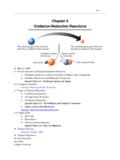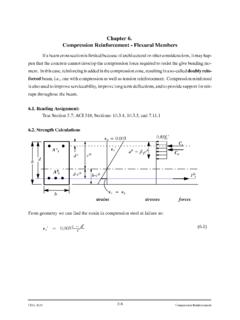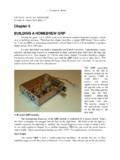Transcription of Blood Gas and Critical Care Analyte Analysis
1 VikaSuh/ShutterStock, Inc. chapter 6. Blood Gas and Critical care Analyte Analysis Maria Delost chapter OBJECTIVES point of care (POC) in Critical care areas such as the emergency department, neonatal and adult medical 1. List the types of samples that can be analyzed for Blood gas and Analyte concentrations. intensive care units, surgical intensive care units, and 2. Describe the three phases of Analysis . the operating 3. Explain the types of errors that can occur with Blood gas The collection and Analysis by portable or standard Analysis . Blood gas machines at or near the point of care mini- 4. Calculate oxygen content. mizes the time needed to obtain and report laboratory 5. Define Westgard rules. 6. Distinguish between shift and drift. values, which facilitates timely evaluation of results and 7. Describe the QC process for a point-of- care testing device. prompt Although the basic principles of operation for Blood gas analyzers haven't changed signif- KEY TERMS icantly from earlier units, the components were notably adapted in 2005.
2 At that time, self-contained cartridges Acid Electrochemical cell Amperometry Electrode were introduced into several analytical systems, pav- Analyte Oxidation ing the way for point-of- care testing and compact units. Anode Partial pressure of oxygen During this innovative period, additional analytes were Base (pO2) incorporated into the testing menus. Today, healthcare Buffer Potentiometric facilities have the option of selecting analyzers to meet a Cathode Pulse oximetry CO oximetry Reduction variety of clinical needs and testing Early Blood gas analyzers were high maintenance and temperamental instruments that required oper- Introduction ator-generated maintenance, calibration, and quality Blood gas Analysis provides Critical information to control. These units only measured the pH, partial healthcare providers that assists in the diagnosis and pressure of oxygen (pO2), and partial pressure of carbon treatment of a variety of metabolic and respiratory dioxide (pCO2) and provided calculated or derived val- disorders.
3 Historically, clinical laboratory testing was ues for other parameters. Today, auto-calibration and performed by medical laboratory scientists and medical verification modes provide a more predictable testing laboratory technicians. Today, Blood gas Analysis is atmosphere for the measurement of pH, pO2, pCO2, performed by trained personnel not only in the central hemoglobin, electrolytes, and metabolites such as glu- or core laboratory, but by respiratory therapists1 in cose, lactate, and Of course, calibration satellite laboratories or with portable devices at the and quality control remain paramount in the accurate 151. 151 01/10/14 6:44 PM. 152 chapter 6 Blood Gas and Critical care Analyte Analysis measurement and reporting of all values obtained from subject to variables that are not accounted for, contrib- Blood gas analyzers. uting to error. Percutaneous arterial puncture or arterial sampling from an indwelling catheter with measurement by a point of care or standard analyzer remains the gold Common Abbreviating Symbols standard for Analysis .
4 Fiber-optic catheters may be and Acronyms used for invasive in vivo Analysis of pH, pCO2, and pO2. Symbols for electrolytes and analytes are summarized The indwelling catheters and Analysis system allow in Table 6-1. The testing of these analytes is described for continuous Blood gas monitoring with minimal later in the chapter . Table 6-3 summarizes common Blood Continuous monitoring of pCO2, pO2, symbols and acronyms used in Blood gas testing. and oxygen saturation can be accomplished through noninvasive methods by transcutaneous monitors and pulse oximeters, respectively. Noninvasive methods Specimen Type and involve minimal risk to the patient and require no spec- imen; a continuous measurement is obtained by placing Origin Symbols electrodes or probes on the body. Blood gases can be analyzed on a variety of specimen types, including arterial, venous, and capillary samples. The collection site is based on the patient's diagnostic Common Nomenclature for Blood needs and clinical condition.
5 In general, collection Gases and Analytes of an arterial specimen by percutaneous puncture or Nomenclature and reference ranges for analytes and indwelling catheter is recommended. Heparin is the arterial Blood gas parameters are summarized in preferred anticoagulant used in the syringe for speci- Tables 6-1 and 6-2, respectively. Reference ranges may men ,9 Venous specimens may be suitable if vary slightly and are based on the methodology, age of pH, pCO2, and bicarbonate values are needed. Results the patient, and reference values the particular health- from venous specimens are affected by metabolism and care facility The reference ranges listed in this peripheral circulation. Arterialized capillary samples chapter are a guide. Blood gas instruments directly can be collected from the earlobe, finger, toe, or heel. measure the pH, pO2, and pCO2; other parameters, When collecting capillary Blood from the heel, the site such as the bicarbonate, oxygen saturation, and base should first be massaged or carefully warmed.
6 Heel col- excess, are derived or calculated values. Direct mea- lection is not suitable once an infant has reached 2 to 3. surements are more accurate and reliable; the param- months of age. Capillary specimens are collected into eters automatically calculated by the analyzer may be heparinized micro-collection tubes. TABLE 6-1. Analyte Nomenclature and Symbols Analyte Symbol Reference Range Comments Potassium K+ mmol/L Major intracellular cation Sodium Na+ 136 145 mmol/L Major extracellular cation; important in maintaining osmotic pressure Chloride Cl 98 107 mmol/L Major extracellular anion Calcium Ca2+ mg/dL (total) Occurs in three forms: bound to plasma proteins, complexed with ions such as bicarbonate, and ionized or free, which is the physiologically active form Magnesium Mg2+ mg/dL Role in many cellular enzymes for metabolism Glucose 75 105 mg/dL Increased in hyperglycemia and diabetes mellitus; decreased values termed hypoglycemia Creatinine mg/dL Index of renal function and glomerular filtration Blood urea nitrogen BUN 6 20 mg/dL Major nitrogen-containing end product of protein metabolism Lactate mg/dL Lactic acidosis may be hypoxic (shock, hypovolemia) or metabolic (venous plasma) (diabetes mellitus, hepatic disease, neoplasms).
7 < mg/dL (arterial Blood in heparin). 152 01/10/14 6:44 PM. Introduction to General Measurement Concepts 153. TABLE 6-2. Nomenclature and Symbols for Arterial Blood Gas Parameters Reference Parameter Description Range Comments pH Negative logarithm of the hydrogen ion Direct measure by pH (Sanz) electrode concentration; measure of acid base balance of Blood . pO2 Partial pressure of oxygen in arterial 80 110 mm Hg Direct measure by pO2 (Clark) electrode Blood . Also written as paO2. pCO2 Partial pressure of carbon dioxide in 35 55 mm Hg Direct measure by pCO2 (Stowe-Severinghaus). arterial Blood ; mainly regulated by electrode respiratory system. Also written as paCO2. HCO3 Bicarbonate; includes true bicarbonate, 21 28 mmol/L Actual bicarbonate is a derived measurement bicarbonate, and dissolved free CO2. serum; calculated from the pH and pCO2 of an aerobically 18 23 mmol/L drawn arterial specimen. Standard bicarbonate is arterial derived from the Henderson-Hasselbalch equation and indicates the bicarbonate level in an oxygenated plasma specimen at F (37 C) and pCO2 of 40 mm Hg.
8 SO2 Oxygen saturation of hemoglobin 95 100% Derived value calculated using sO2% = cO2Hb/(cO2Hb + cHHb) 100. Calculated value does not account for other hemoglobins or actual pCO2. Oxyhemoglobin is directly measured using oximetry. P50 pO2 at which hemoglobin is 50% Calculated parameter saturated with oxygen. Buffer base Total of all anionic buffers in the Blood ; 44 48 mmol/L Calculated parameter; should not be affected by includes hemoglobin, bicarbonate, respiratory disorders. inorganic phosphate, and proteins with a negative charge. Base excess Number of millimoles of strong acid Calculated parameter; should not be affected by needed to titrate a Blood sample to pH respiratory disorders. at pCO2 40 mm Hg. cHHb = content of deoxygenated hemoglobin; cO2Hb = content of oxygenated hemoglobin Introduction to General pO2 refers to the partial pressure or tension of oxygen; it may also be written as PO2 , PO2 , and Measurement Concepts reference range of pO2 in arterial Blood is Gas Tension 80 110 mmol/L.
9 PCO2 refers to the partial pressure Gas tension is the partial pressure of a gas in Blood . or tension of carbon dioxide; it may also be written as Partial pressure refers to the pressure exerted by a PCO2 , PCO2 , or pCO2 . The reference range of pCO2. single gas in a mixture of gases or in a liquid. The pres- for arterial Blood is 35 45 mm Hg. sure of the gas is related to the concentration of the gas to the total pressure of the mixture. For example, the concentration of oxygen in the atmosphere is pH. Atmospheric pressure is 760 mm Hg (at sea level). The The pH is a measure of the acidity or alkalinity of a partial pressure of oxygen in the atmosphere can be solution and ranges from 1 14. Values less than calculated by multiplying the concentration of this gas are acidic and greater than are alkaline. An acid in the atmosphere ( ) by atmospheric pressure is a substance that produces or donates hydrogen (760 mm Hg).10 ions [H+] when dissolved in water, whereas a base or alkaline substance is one that produces or donates Gas tension of oxygen in the atmosphere =.
10 Hydroxyl ions [OH ] when dissolved in water. When 760 mm Hg = 160 mm Hg there are equal numbers of [H+] and [OH ] ions, the 153 01/10/14 6:44 PM. 154 chapter 6 Blood Gas and Critical care Analyte Analysis TABLE 6-3. Common Symbols and Acronyms Related to Blood Gas Testing Symbol Meaning pO2 Partial pressure of oxygen; also written as PO2, pO2, or PO2. pCO2 Partial pressure of carbon dioxide; also written as PCO2, pCO2, or PCO2. [H+] Hydrogen ion concentration [OH ] Hydroxyl ion concentration Hb Hemoglobin COHb Carboxyhemoglobin HHb Reduced or deoxygenated hemoglobin O2Hb Oxygenated hemoglobin or oxyhemoglobin THb Total hemoglobin sO2 Oxygen saturation of hemoglobin P50 pO2 at which 50% of hemoglobin is saturated ctO2 Oxygen content QA Quality assurance QC Quality control solution is neutral and the pH is , as shown in the cell or electrode has a glass membrane with layers of following equation:10 hydrated and nonhydrated glass. It is permeable or sensitive to hydrogen [H+] ions.

















